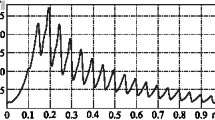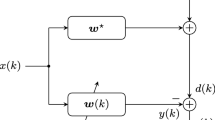Abstract
An iterative learning control scheme is described for linear discrete-time systems. A weighted least-squares criterion of learning error is optimized to obtain a unique control gain for a case when the number of sampling is relatively small. It is then shown that algorithmic convergence can be readily guaranteed, because the present learning rule consists of a steady-state Kalman filter. By paying attention to the sparse system structure for the system's impulse response model, we further derive a suboptimal iterative learning control for a practical case when the number of sampling is large.
Similar content being viewed by others
Explore related subjects
Discover the latest articles, news and stories from top researchers in related subjects.References
Arimoto, S., Kawamura, S., and Miyazaki, F., 1984, Bettering operation of robots by learning, J. Robotic Systems 1(2), 123–140.
Arimoto, S., Kawamura, S., Miyazaki, F., and Tamaki, S., 1985, Learning control theory for dynamic systems, Proc. 24th Conference on Decision and Control, pp. 1375–1380.
Bien, Z. and Huh, K.M., 1989, Higher-order iterative learning control algorithm, IEEE Proceedings 136(D)(3), 105–112.
Bondi, P., Casalino, G., and Gambardella, L., 1988, On the iterative learning control theory for robotic manipulators, IEEE J. Robotics and Automation 4(1), 14–22.
Furuta, K. and Yamakita, M., 1987, The design of a learning control systems for multivariable systems, Proc. IEEE Int. Symp. Intelligent Control, Philadelphia, PA, pp. 371–376.
Goodwin, G.C. and Sin, K.S., 1984, Adaptive Filtering Prediction and Control, Prentice-Hall.
Hodzic, M. and Siljak, D.D., 1985, Estimation and control of large sparse systems, Automatica 21(3), 277–292.
Ishihara, T., Abe, K., and Takeda, H., 1986, A design of discrete-time repetitive control systems, Trans. Soc. Instrum. Control Eng. 22(1), 43–49 (in Japanese).
Ishihara, T., Shiozuka, H., Abe, K., and Takeda, H., 1987, Design of discrete-time iterative using uncertain impulse response sequence, Trans. Soc. Instrum. Control Eng. 23(9), 55–60 (in Japanese).
Kawamura, S., Miyazaki, F., and Arimoto, S., 1985a, Applications of learning method for dynamic control of robot manipulators, Proc. 24th Conference on Decision and Control, pp. 1381–1386.
Kawamura, S., Miyazaki, F., and Arimoto, S., 1985b, System theoretic study on learning control method, Trans. Soc. Instrum. Control Eng. 21(5), 23–28 (in Japanese).
Kawamura, S., Miyazaki, F., and Arimoto, S., 1986a, Proposal of betterment process: A learning control method for daynamical systems, Trans. Soc. Instrum. Control Eng. 22(1), 56–62 (in Japanese).
Kawamura, S., Miyazaki, F., and Arimoto, S., 1986b, Learning control of motion for robot manipulator, Trans. Soc. Instrum. Control Eng. 22(4), 69–76 (in Japanese).
Kawamura, S., Miyazaki, F., and Arimoto, S., 1988, Realization of robot motion based on a learning method, IEEE Trans. Systems Man Cybernet. SMC-18(1), 126–134.
Mendel, J.M., 1987, Lessons in Digital Estimation Theory, Prentice-Hall.
Mita, T., Kato, E., and Aoki, Y., 1985, Iterative control and its applications to the trajectory control of robot manipulators, Trans. Soc. Instrum. Control Eng. 21(11), 87–94 (in Japanese).
Nishida, Y., Sugie, T., and Ono, T., 1989, A digital learning, control considering input saturation and disturbances, Trans. Institute of Systems, Control and Information Eng. 2(3), 80–87 (in Japanese).
Oh, S.R., Bien, Z., and Suh, I.H., 1988, An iterative learning control method with application for the robot manipulators, IEEE J. Robotics and Automation 4(5), 508–514.
Sugie, T. and Ono, T., 1987, On a learning control law, Systems and Control 31(2), 129–135 (in Japanese).
Takeda, M., Masuda, T., Futakawa, A., Kawamura, S., Miyazaki, F., and Arimoto, S., 1987, Learning control for robots based on linear approximation of inverse system. J. Robotics Soc. Japan 5(2), 55–64 (in Japanese).
Togai, M. and Yamano, O., 1985, Analysis and design of an optimal learning control scheme for industrial robots: A discrete system approach, Proc. 24th Conference on Decision and Control, pp. 1399–1404.
Uchiyama, M., 1978, Formulation of high-speed motion pattern of a mechanical arm by trial, Trans. Soc. Instrum. Control Eng. 14(6), 94–100 (in Japanese).
Author information
Authors and Affiliations
Rights and permissions
About this article
Cite this article
Watanabe, K., Fukuda, T. & Tzafestas, S.G. An interative learning control scheme using the weighted least-squares method. J Intell Robot Syst 4, 267–284 (1991). https://doi.org/10.1007/BF00303227
Received:
Issue Date:
DOI: https://doi.org/10.1007/BF00303227




